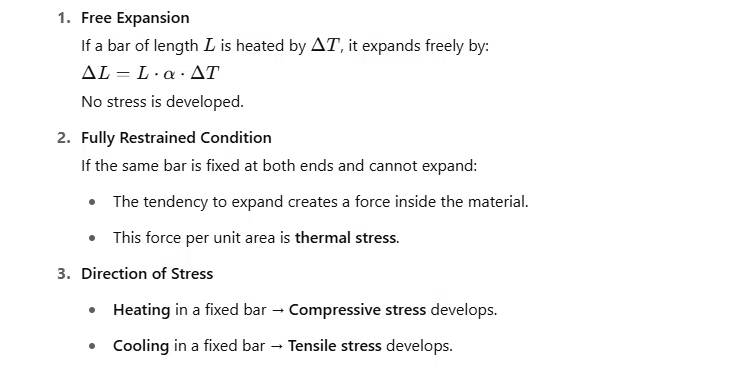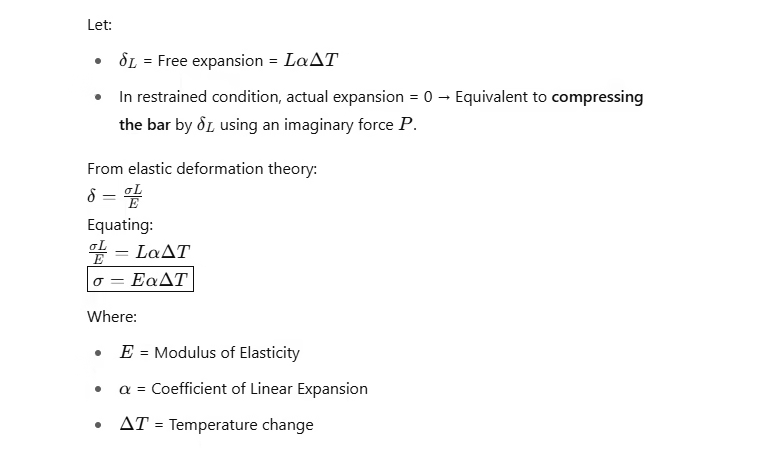Updated on: 14 August 2025
Exam Tags: JKSSB JE Civil, SSC JE, RRB JE, State PSC, Diploma Exams
🔍 Introduction
In Strength of Materials (SOM), most stresses are traditionally attributed to external loads such as point loads, distributed loads, or bending moments. However, in many real-world engineering scenarios, stresses develop without any direct external load — purely as a result of temperature variations in the material. This phenomenon is known as Thermal Stresses, and it is highly significant for civil engineering design, structural safety, and competitive exams like JKSSB JE Civil.
When a material is heated, it undergoes thermal expansion, and when cooled, it experiences thermal contraction. In a completely free condition, these dimensional changes occur without generating any internal forces. But when the material’s deformation is partially or fully restrained (e.g., fixed ends of a steel rod, embedded concrete beams, welded structures), internal tensile or compressive stresses are induced. These stresses can lead to cracking, buckling, joint failure, or long-term fatigue if not properly accounted for in the design.
📌 Why Thermal Stresses Matter for Civil Engineers
- Structural Safety: High thermal stresses can cause cracks in concrete, spalling of the surface, loss of bond between steel reinforcement and concrete, or even buckling in steel members if not designed for adequate expansion/contraction allowances. Such effects can compromise serviceability, reduce load-carrying capacity, and lead to long-term durability issues in civil engineering structures.
- Durability: Continuous thermal cycling (day/night, seasonal) can fatigue a material by causing repeated expansion and contraction, leading to micro-cracks, progressive weakening, loss of stiffness, and eventual fracture. In concrete, this can accelerate freeze-thaw damage in colder climates, while in metals, it can initiate fatigue cracks that propagate over time.
- Design Codes: IS codes require engineers to consider temperature effects in bridges, pavements, pipelines, and tanks, specifying permissible stress limits, expansion joint requirements, reinforcement detailing for crack control, and material selection guidelines to ensure long-term structural integrity under varying thermal conditions.
- Exam Relevance: JKSSB, SSC, and RRB exams test both the formula and practical reasoning.
📖 Concept of Thermal Stresses

🧮 Derivation of Thermal Stress Formula

📊 Table: Coefficient of Linear Expansion
| Material | α × 10⁻⁶ /°C |
|---|---|
| Steel | 11–12 |
| Concrete | 9–12 |
| Copper | 17 |
| Aluminum | 23 |
| Glass | 9 |
🔎 Cases of Thermal Stresses in Civil Engineering
Case 1: Uniform Temperature Change

Case 2: Temperature Gradient in Depth
- Occurs in pavements, slabs, bridge decks exposed to sunlight.
- Top expands more than bottom → bending stresses develop.
Case 3: Composite Members (Bi-material)
- Example: Steel rod encased in concrete, both restrained.
- Different α values → differential expansion → internal stress redistribution.
📏 Thermal Strain

🛠 Real-life Applications & Examples
- Railway Tracks – Gaps between rails allow for summer expansion and winter contraction.
- Bridges & Flyovers – Expansion joints at piers prevent deck slab cracks.
- Pipelines – Expansion loops/bends absorb thermal movement.
- Concrete Pavements – IS:456 recommends expansion joints.
- Dams – Cooling pipes reduce temperature gradients.
📝 Example Problem 1
Q: A 3 m steel rod (E = 210 GPa, α = 11 × 10⁻⁶ /°C) is fixed at both ends. The temperature rises by 40°C. Find the thermal stress.

📝 Example Problem 2 (Composite Bar)

Key Point: Different α values cause unequal free expansion, leading to internal force balancing.
🏁 Conclusion
Thermal stresses are unavoidable in structures exposed to temperature changes due to restrained expansion or contraction of materials. For JKSSB Civil Engineering exams, you must:

- Understand the underlying concept that if a material is free to expand, no thermal stress develops, but if it is restrained, internal stresses are induced.
- Know practical applications such as expansion joints in bridges, gap allowances in railway tracks, and thermal reinforcement in concrete.
- Be able to solve both numerical problems (including unit conversions) and conceptual questions related to temperature effects, thermal strain, and compatibility conditions.
📌 Previous Year Questions (PYQs) on Thermal Stresses

Q2. Thermal stress occurs in a material when:
A) Temperature changes but material is free to expand
B) Temperature changes and expansion is restrained ✔️
C) No temperature change but load is applied
D) The material is perfectly elastic
Correct Answer: B
Q3. If a copper bar is heated but free to expand, the stress produced will be:
A) Tensile
B) Compressive
C) Zero ✔️
D) Shear
Correct Answer: C
Q4. Which of the following factors does not influence thermal stress in a member?
A) Modulus of elasticity
B) Coefficient of thermal expansion
C) Temperature change
D) Density of the material ✔️
Correct Answer: D
Q5. In railway tracks, gaps are left between rails to:
A) Reduce friction
B) Avoid buckling due to thermal expansion ✔️
C) Allow drainage
D) Reduce noise
Correct Answer: B
📌 FAQs on Thermal Stresses
Q1. What is the formula for thermal stress in a fully restrained member?

Q2. Can thermal stresses be tensile or compressive?
Yes. Heating in a restrained condition produces compressive stresses; cooling produces tensile stresses.
Q3. How are thermal stresses relieved in structures?
By providing expansion joints, using materials with lower α\alphaα, or allowing partial movement.
Q4. Are thermal stresses considered in all structures?
They are crucial in bridges, pavements, pipelines, and large steel structures, but may be negligible in small components.
Q5. Why are expansion joints filled with compressible material?
To absorb movement due to temperature changes and prevent cracking or buckling.
📌 Join our Telegram Channel JKSSB CivilsCentral for regular updates, quizzes, PDF notes, and practice sets curated specifically for JKSSB aspirants.


